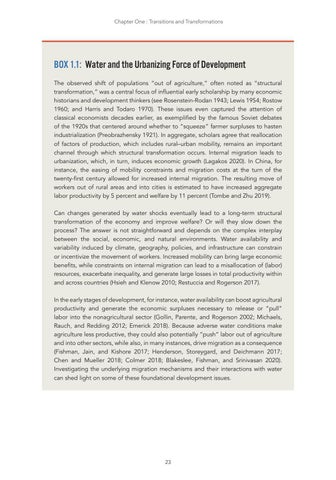Chapter One : Transitions and Transformations
BOX 1.1: Water and the Urbanizing Force of Development The observed shift of populations “out of agriculture,” often noted as “structural transformation,” was a central focus of influential early scholarship by many economic historians and development thinkers (see Rosenstein-Rodan 1943; Lewis 1954; Rostow 1960; and Harris and Todaro 1970). These issues even captured the attention of classical economists decades earlier, as exemplified by the famous Soviet debates of the 1920s that centered around whether to “squeeze” farmer surpluses to hasten industrialization (Preobrazhensky 1921). In aggregate, scholars agree that reallocation of factors of production, which includes rural–urban mobility, remains an important channel through which structural transformation occurs. Internal migration leads to urbanization, which, in turn, induces economic growth (Lagakos 2020). In China, for instance, the easing of mobility constraints and migration costs at the turn of the twenty-first century allowed for increased internal migration. The resulting move of workers out of rural areas and into cities is estimated to have increased aggregate labor productivity by 5 percent and welfare by 11 percent (Tombe and Zhu 2019). Can changes generated by water shocks eventually lead to a long-term structural transformation of the economy and improve welfare? Or will they slow down the process? The answer is not straightforward and depends on the complex interplay between the social, economic, and natural environments. Water availability and variability induced by climate, geography, policies, and infrastructure can constrain or incentivize the movement of workers. Increased mobility can bring large economic benefits, while constraints on internal migration can lead to a misallocation of (labor) resources, exacerbate inequality, and generate large losses in total productivity within and across countries (Hsieh and Klenow 2010; Restuccia and Rogerson 2017). In the early stages of development, for instance, water availability can boost agricultural productivity and generate the economic surpluses necessary to release or “pull” labor into the nonagricultural sector (Gollin, Parente, and Rogerson 2002; Michaels, Rauch, and Redding 2012; Emerick 2018). Because adverse water conditions make agriculture less productive, they could also potentially “push” labor out of agriculture and into other sectors, while also, in many instances, drive migration as a consequence (Fishman, Jain, and Kishore 2017; Henderson, Storeygard, and Deichmann 2017; Chen and Mueller 2018; Colmer 2018; Blakeslee, Fishman, and Srinivasan 2020). Investigating the underlying migration mechanisms and their interactions with water can shed light on some of these foundational development issues.
23



